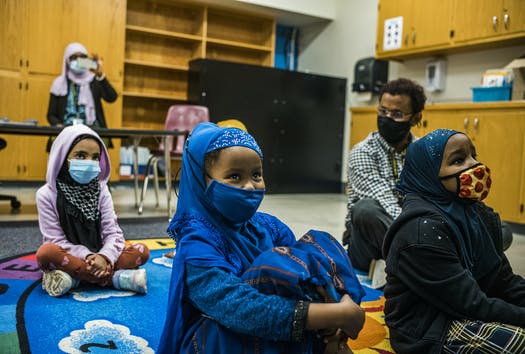The program is following a model created by the Hmong language program, which began in the district in 2004.

By Mara Klecker
For weeks now, Sakarie Hassan has come home from kindergarten at Sullivan STEAM Magnet School eager to tell about the words he’s learning to read in Somali, the language he speaks at home. He’ll greet them with “see tahay” (how are you?).
“He likes to show off for family members,” said his mom Nimo Mohamed through a translator. “As a mom, I’m so grateful he’s getting to learn his home language at school.”
Hassan is one of about 100 students in Minneapolis Public School’s new Somali Heritage Language program, launched this year for grades K-2 at Sullivan and Lyndale Community School — two schools with a high concentration of the district’s 2,900 Somali students. While not a full immersion model offering all-day instruction in Somali, the elective class focuses on teaching students to read and write in the language.
The program is modeled in part after a similar effort for Hmong-speaking students, which began in the district in 2004. Hmong students can begin a dual-language pathway at the Hmong International Academy and continue learning about the language and culture through high school. Paid for out of the district’s general fund, both the Hmong and Somali programs are aimed at serving native speakers and designed to help prevent young students from losing their parent tongue.
“There was really a need for this,” said Muhidin Warfa, executive director of the district’s multilingual department. “Families were starting to feel disconnected from their own kids, especially those who were born here. As the students were immersed in English, they were no longer able to communicate with their own families or communities.”
A handful of other districts across the state offer Somali and Hmong classes aimed at second-generation students. Last year, St. Cloud schools started a Somali class for native-speaking high schoolers and recently expanded it because of high demand. Warfa has also received inquiries from several other public and charter schools — both in Minnesota and across the country — interested in starting their own such programs.
“We are seeing more and more interest in these kinds of language heritage programs,” said Ayumi Stockman, a world languages education specialist at the Minnesota Department of Education.
The programs have a twofold benefit, Stockman said. Research has shown that students who develop and learn the structure of their home language have more success in learning a second language.
“It’s also just an affirmation of the students’ identity,” Stockman said. “Language and identity are really tied together. These programs provide the space for that affirmation.”
On a recent morning, four Somali kindergartners sat cross legged on the floor in Anwar Mohamed’s classroom at Sullivan. After a quick review of the classroom rules, he began a lesson on the Somali alphabet. During the half-hour class, Mr. Anwar spoke Somali. The students occasionally slipped into English, but enthusiastically repeated letters and completed worksheets in Somali.
Mr. Anwar works with the students’ other teachers to ensure his lessons match the literacy learning targets that the rest of the class is focused on.
“We make sure we hit those learning targets,” he said. “This helps them develop those reading skills to be bilingual, which we know helps them academically and also just throughout their life.”
That classroom instruction is crucial to understanding a language, said Hibo Nuur, whose daughter is a kindergartner in the Somali program at Sullivan. While she knows her daughter can speak Somali now, she wants her to learn more from those outside of her family.
“We need to keep knowing who we are even as we learn English and about American culture,” Nuur said. “We don’t want to lose our language, our culture or our dignity from generation to generation.”
Gao Xiong, the principal of the Hmong International Academy, said the school’s Hmong program has offered a way to help preserve the language and encourage students to be proud of their culture. Despite its name, the academy is a community school open to all students. About 100 native speakers are enrolled in the Hmong language program.
“For me, it’s about giving them that inclusive space so they aren’t embarrassed, but rather proud, to be Hmong,” Xiong said.
The Hmong language had no written form until the mid 20th century, making it all the more important for programs that encourage young people to continue practicing and preserving the language, said Jerry Toojntxawg Lee, a father of eight children. His youngest is a first-grader at Hmong International Academy and he hopes her classes will help her maintain her “Hmong tongue,” he said. Some of his older children speak primarily in English, even when they’re home, he said.
“To have this offering gives home to the first generation and support for that younger generation that is kind of stuck in the middle of two cultures,” Lee said. “Having that connection to their roots is important … and it can be hard for parents to teach all that at home.”
Mariam Adam, the lead ESL teacher at Sullivan, said parents in the community had been pushing for a Somali heritage language program for several years. Though the program is only available to the school’s youngest students for now, the district plans to offer more grade levels each year so the students can continue their Somali instruction as they grow older.
“This is just a start,” Adam said. “But we’re blessed that the district has listened and recognized this as a need.”
Source: StarRtibune


